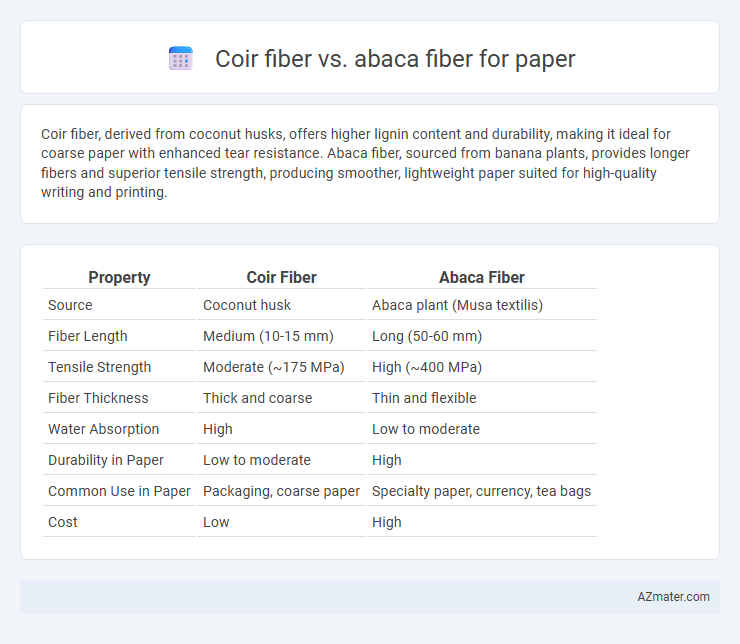Coir fiber, derived from coconut husks, offers higher lignin content and durability, making it ideal for coarse paper with enhanced tear resistance. Abaca fiber, sourced from banana plants, provides longer fibers and superior tensile strength, producing smoother, lightweight paper suited for high-quality writing and printing.
Table of Comparison
| Property | Coir Fiber | Abaca Fiber |
|---|---|---|
| Source | Coconut husk | Abaca plant (Musa textilis) |
| Fiber Length | Medium (10-15 mm) | Long (50-60 mm) |
| Tensile Strength | Moderate (~175 MPa) | High (~400 MPa) |
| Fiber Thickness | Thick and coarse | Thin and flexible |
| Water Absorption | High | Low to moderate |
| Durability in Paper | Low to moderate | High |
| Common Use in Paper | Packaging, coarse paper | Specialty paper, currency, tea bags |
| Cost | Low | High |
Overview: Coir Fiber and Abaca Fiber in Papermaking
Coir fiber, derived from coconut husks, is coarse and has high lignin content, making it ideal for producing durable and stiff paper products such as packaging materials and cardboard. Abaca fiber, extracted from the Musa textilis plant, offers longer fibers with superior strength, flexibility, and tear resistance, commonly used in specialty papers like currency, tea bags, and high-end paper products. Both fibers contribute unique properties to papermaking, with coir providing ruggedness and abaca delivering enhanced tensile strength and smoothness.
Botanical Sources and Geographic Origins
Coir fiber is extracted from the outer husk of the coconut palm (Cocos nucifera), predominantly cultivated in tropical regions of India, Sri Lanka, and the Philippines, making it a durable and coarse material ideal for paper production requiring high strength. Abaca fiber, derived from the Musa textilis plant native to the Philippines and parts of Central America, is finer and stronger with excellent tensile properties, often favored for specialty papers and currency notes. The distinct botanical sources and geographic origins influence their fiber structure, availability, and suitability for different paper manufacturing applications.
Physical and Chemical Properties Comparison
Coir fiber exhibits higher lignin content (approximately 45-50%) compared to abaca fiber (around 10-12%), resulting in greater rigidity and resistance to microbial degradation, making coir suitable for coarse paper products. Abaca fiber has superior tensile strength (up to 400 MPa) and cellulose content (about 60-65%), providing enhanced durability and flexibility ideal for high-quality paper applications like currency and specialty papers. The physical structure of coir is coarse and thick, while abaca fibers are finer and longer, influencing the texture and strength of the resulting paper significantly.
Fiber Extraction Methods
Coir fiber extraction employs a water retting process where coconut husks are soaked to loosen the fibers, followed by mechanical decortication to separate coarse fibers suitable for durable paper products. Abaca fiber extraction uses a manual or mechanical stripping method to remove bundles from leaf sheaths, relying on controlled water retting that softens the fibers while preserving their strength and flexibility for high-quality specialty paper. Both extraction methods impact fiber length, strength, and lignin content, critical parameters for selecting fibers in paper manufacturing applications.
Mechanical Strength and Durability in Paper
Coir fiber offers high tensile strength and excellent durability, making it suitable for reinforcing paper with enhanced mechanical strength and resistance to wear. Abaca fiber, known for its superior fiber length and natural flexibility, provides exceptional tear resistance and durability in paper products. Papers incorporating abaca fibers exhibit higher burst strength and folding endurance compared to those made with coir fibers.
Pulping Processes: Coir vs Abaca
Coir fiber pulping for paper involves a chemical process using soda or kraft pulping to remove lignin from the high lignin content, resulting in coarse pulp with lower brightness and strength. Abaca fiber pulping typically employs the kraft process, producing a stronger, finer pulp due to its lower lignin and higher cellulose content, making abaca ideal for specialty papers and high-grade packaging. The differences in fiber composition influence pulping recovery rates, chemical consumption, and the quality of the resulting pulp.
Environmental Impacts and Sustainability
Coir fiber, derived from coconut husks, is highly sustainable due to its biodegradability and low environmental footprint, promoting waste valorization by repurposing agricultural byproducts. Abaca fiber, sourced from the banana plant, offers superior strength and durability for paper production while supporting sustainable agroforestry practices that enhance soil health and biodiversity. Both fibers reduce reliance on wood pulp, lowering deforestation rates and carbon emissions in paper manufacturing.
Cost and Commercial Availability
Coir fiber, derived from coconut husks, is more cost-effective than abaca fiber, making it a popular choice for budget-sensitive paper production. Abaca fiber, sourced from the banana plant, commands a higher price due to its superior strength and durability in specialty paper applications. Commercial availability favors coir fiber, as it is abundantly produced in tropical regions, whereas abaca has a more limited supply, concentrated mainly in the Philippines and parts of Southeast Asia.
Applications in Specialty and Industrial Papers
Coir fiber and Abaca fiber are both valued for their durability and tensile strength in specialty and industrial paper applications. Coir fiber is commonly used in carpet backing, doormats, and geotextiles due to its coarse texture and resistance to wear and moisture. Abaca fiber, known for its exceptional flexibility and lightweight properties, is preferred in the production of tea bags, currency notes, and high-quality specialty papers requiring superior strength and dimensional stability.
Summary: Choosing the Right Fiber for Paper Making
Coir fiber, derived from coconut husks, offers high durability and coarse texture ideal for making robust and water-resistant paper products. Abaca fiber, sourced from the abaca plant, is prized for its long, strong, and flexible strands that produce lightweight, smooth, and tear-resistant paper favored in specialty and currency papers. Selecting between coir and abaca depends on the desired paper characteristics: durability and water resistance suit coir, while strength, flexibility, and smoothness favor abaca fibers.

Infographic: Coir fiber vs Abaca fiber for Paper
 azmater.com
azmater.com